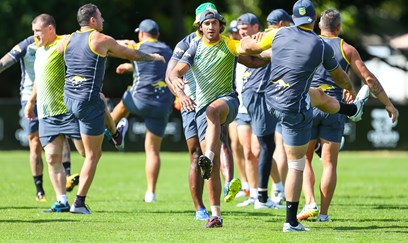For rugby league fans, the NRL season is a spectacle of athleticism, skill, and strategy. But what happens behind the scenes? How do players prepare themselves for the rigors of game day? In this article, we take you behind the curtain and provide a detailed glimpse into a typical NRL training session, from warm-up to cool-down.

Warm-Up: Setting the Foundation A typical NRL training session begins with a comprehensive warm-up designed to prepare players physically and mentally for the challenges ahead. Players gather on the training field under the watchful eye of the coaching staff, ready to embark on a series of dynamic exercises.
The warm-up typically starts with light jogging and dynamic stretching to increase blood flow and loosen tight muscles. This is followed by mobility drills, such as leg swings, arm circles, and hip rotations, to improve range of motion and flexibility. As the warm-up progresses, players may incorporate more sport-specific movements, such as lunges, squats, and lateral shuffles, to mimic the actions they’ll perform during training drills and games.
Skills and Drills: Sharpening Technique With bodies primed and minds focused, players transition into the heart of the training session: skills and drills. This portion of the session is where players hone their technical abilities, refine their decision-making skills, and develop their understanding of team strategies.
Training drills can vary widely depending on the focus of the session and the specific needs of the team. Some common drills include:
- Ball Handling Drills: Players work on their passing accuracy, ball security, and offloading techniques through a series of passing and catching drills. These drills may involve stationary passing, dynamic passing while on the move, and pressure passing with defenders in close proximity.
- Footwork Drills: Footwork is crucial in rugby league, and players dedicate time to improving their agility, balance, and change of direction. Footwork drills often involve ladder drills, cone drills, and agility ladder exercises to enhance speed and agility.
- Contact Drills: Rugby league is a collision sport, and players must be prepared for the physicality of the game. Contact drills focus on tackling technique, body positioning, and defensive alignment. Players may engage in one-on-one tackling drills, wrestle and hold exercises, and controlled contact scenarios to simulate game-like situations.
- Game Simulation: To replicate the intensity and flow of a real match, training sessions often include game simulation drills. Players participate in structured scrimmages or modified games that emphasize tactical awareness, decision-making under pressure, and teamwork.
Throughout these drills, coaches provide feedback, instruction, and encouragement to help players improve their skills and understand their roles within the team structure.
Conditioning: Building Endurance and Fitness In addition to skill development, conditioning is a key component of NRL training sessions. Rugby league is a demanding sport that requires players to maintain high levels of endurance, speed, and strength throughout the course of a game.
Conditioning drills may include:
- Sprint Intervals: Players engage in repeated sprints of varying distances to improve anaerobic fitness and speed. These intervals may be performed on the training field or on a nearby running track.
- Cardiovascular Circuits: Circuits incorporate a variety of cardiovascular exercises, such as shuttle runs, burpees, and jumping jacks, to elevate heart rate and build overall fitness.
- Strength and Power Training: Strength and power are essential attributes for rugby league players, and strength training exercises are often incorporated into training sessions. Players may perform exercises such as squats, deadlifts, bench presses, and plyometric drills to develop strength, power, and explosiveness.
Cool-Down: Recovery and Regeneration As the training session draws to a close, players shift their focus to recovery and regeneration. The cool-down phase is designed to promote muscle relaxation, reduce muscle soreness, and facilitate the recovery process.
Cool-down activities may include:
- Static Stretching: Players engage in gentle stretching exercises to target major muscle groups and improve flexibility. Static stretches are held for 20-30 seconds to promote relaxation and elongation of the muscles.
- Foam Rolling: Foam rolling, or self-myofascial release, is used to release tension and tightness in the muscles. Players use foam rollers to massage areas of discomfort and promote blood flow to aid in recovery.
- Hydration and Nutrition: Proper hydration and nutrition are essential for recovery and performance. Players replenish fluids lost during training with water or sports drinks and consume nutrient-rich foods to support muscle repair and glycogen replenishment.
- Regeneration Modalities: Some teams may incorporate additional recovery modalities, such as ice baths, compression garments, or massage therapy, to enhance recovery and reduce muscle soreness.
As players complete their cool-down routines, they reflect on the intensity of the training session and the areas they need to focus on for improvement. With bodies rejuvenated and minds refreshed, they leave the training field knowing they’ve taken another step towards peak performance on game day.
Conclusion: The Path to Success A typical NRL training session is a meticulously planned and executed endeavor that encompasses a range of activities designed to prepare players physically, technically, and mentally for the challenges of rugby league. From the dynamic warm-up to the skill-focused drills, conditioning exercises, and cool-down rituals, each component plays a vital role in the development and preparation of players for the rigors of NRL competition. As fans, gaining insight into the intricacies of these training sessions allows us to appreciate the dedication, discipline, and teamwork required to excel at the highest level of the sport.
